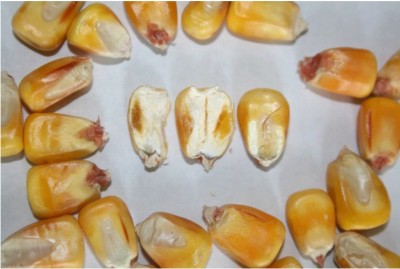Source: Michigan State University Extension
Grain moisture content at different growth stages is fairly well known. Kernel moisture content decreases as the kernels develop through the blister stage (85%), milk stage (80%), dough stage (70%), dent stage (55%), and finally physiological maturity (30%).
 Cross section of corn kernels showing abscission or black layer. Even if black layer is not reached before killing frost, kernel dry down rates are very similar to mature corn and are affected by the same factors, mainly temperature and humidity. |
Physiological maturity occurs when the connective tissues that carry water and nutrients through the cob to the kernel desiccates, forming an abscission layer or black layer. This black layer can be found by removing a kernel from the cob and peeling the skin back at the root where the kernel was attached to the cob (see photo). Black layer is the stage at which kernel weights have peaked. Farmers generally start harvesting corn when the moisture levels get down to 22% to 25%.
Several research projects have focused on field dry down rates on corn (see data in table). Temperature, humidity, hybrid and planting date influence the rate at which corn will dry down. Corn that matures earlier in the season tends to dry more rapidly simply because temperatures are higher. Research conducted at Iowa State University shows that corn that reaches black layer in late August will dry at a rate of 0.8% per day compared to corn that reaches black layer in mid-late September drying at 0.4% per day.
Summary of research findings on average corn dry down rates
|
University |
Grain moisture loss per day (%) |
Comments |
|
Iowa State University |
0.5-0.6 |
Evaluated from late August (dent stage, R5) through October. |
|
University of Nebraska |
0.60-0.64 |
Conventional and transgenic hybrids did not differ in dry down rates. |
|
University of Wisconsin |
0.66 |
|
In general, immature corn (that hasn’t reached black layer) will dry down at the same rate as normal and be impacted by the same factors like temperature and humidity. In years like 2014 where heat unit accumulation is normal or behind normal, and spring rains caused farmers to plant corn later, grain dry down in the fall will take longer and fuel costs for grain drying will go up. When selecting hybrids to plant, Michigan State University Extension recommends you consider planting a range of relative maturities so that you can spread your risk in terms of field dry down.





